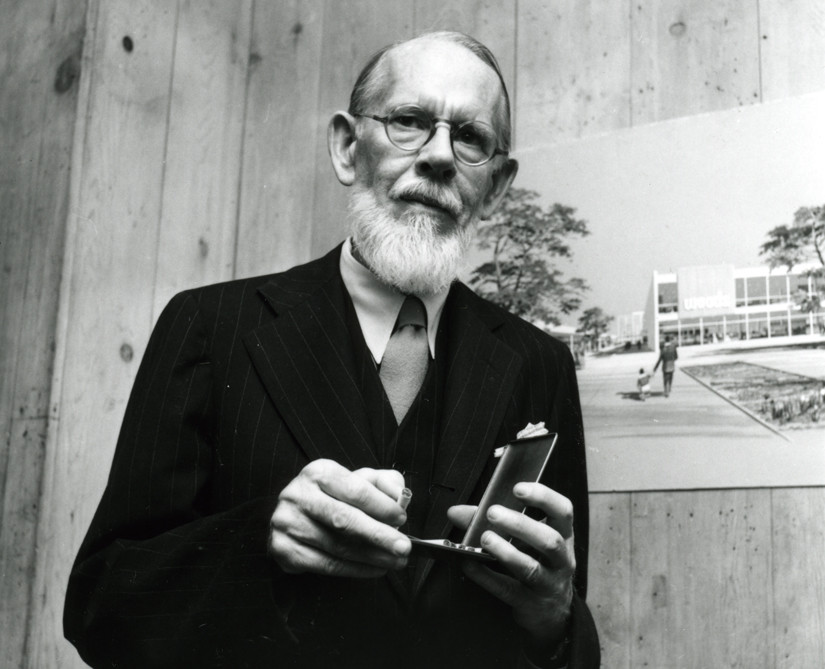
Talbot F. Hamlin
Architect, professor, author, and librarian Talbot F. Hamlin compiled a list of important historical buildings in 1942 that was later used to guide designations by the New York City Landmarks Preservation Commission.
Talbot Faulkner Hamlin (1889-1956) was the son of Minnie Florence Martson and A. D. F. Hamlin, a Professor of Architecture at Columbia University. Talbot Hamlin attended Amherst College, graduating with a B.A. in Classics and English in 1910. He also earned a Bachelors in Architecture in 1914 from Columbia University, where he would spend his lengthy academic career. Hamlin practiced architecture with the firms of Murphy, McGill and Hamlin; McGill and Hamlin; and his private practice. In 1934, Hamlin was appointed as the Librarian of the Avery Architectural Library at Columbia University where he served until 1945 while continuing to teach architectural history at the university. Hamlin is responsible for creating the Avery Architectural Index, and for expanding the library’s holdings to the world-renowned collection that it is today. He also worked as an architectural history instructor at Columbia University early in his career and a professor of architectural history until 1954, a 38-year-long career. Hamlin was also a prolific author who published numerous books and essays on architecture and architectural history. He won the Pulitzer Prize for his book Benjamin Henry Latrobe in 1956. Hamlin expressed his ideas on architecture in letters to the editor of The New York Times.
Society of Architectural Historians
Chairman, 1945
Hamlin's contributions to historic preservation range from his posts at Columbia University to his involvement with groups such as the American Scenic and Historic Preservation Society and his co-founding role in the Society of Architectural Historians to his critical essays that posed questions to the nascent modern preservation movement. Hamlin wrote essays and letters in support of preserving several historic and architectural gems including Battery Park and the row of houses on Washington Square North. His most direct contribution, however, was his compilation of a list of important historic New York buildings: the “Tentative list of Old Buildings of Manhattan built in 1865 or earlier, and worthy of preservation. Annotated by Talbot Hamlin” (1942). This was likely prompted by then-president of the Municipal Art Society, Ely Jacques Kahn's initiative to save "New York's remaining historic buildings, as well as areas." Hamlin's preliminary 1941 inventory reflected his own interest and expertise in the Greek Revival style, but his list was used as a base for expanded indexes by groups including the Society for Architectural Historians, the Municipal Art Society, and the American Institute of Architects for exhibits and publications. Hamlin's list would prove to be the grandfather of New York Landmarks: An Index of Architecturally Notable Structures in New York, and ultimately, Alan Burnham’s New York Landmarks (1963). The formation of Hamlin's early list was key in the movement to take inventory of New York's historic resources to build a constituency for historic preservation and to steer the New York City Landmarks Preservation Commission.
- Talbot Hamlin Papers
Drawings & Archives Department
Avery Architectural & Fine Arts Library
Columbia University
1172 Amsterdam Avenue
New York, NY 10027
Tel: (212) 854-4110
Email: avery-drawings@libraries.cul.columbia.edu
Anthony C. Wood, “Pioneers of Preservation: Part III: Preservation’s Scholarly Roots: Talbot Hamlin and the Avery Library; An Interview with Commissioner Adolf Placzek,” Village Views Vol. 4, No. 4 (Fall 1987): page 15.
- Oral Histories with Harmon Goldstone, Adolf Placzek, and Henry Hope Reed
New York Preservation Archive Project
174 East 80th Street
New York, NY 10075
Tel:(212) 988-8379
Email: info@nypap.org